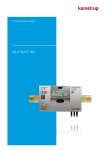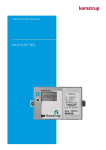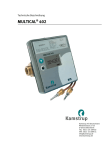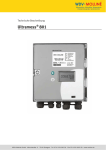Download MC 601 installation guide
Transcript
Instructions for assembly and use MULTICAL 601 ® www.kamstrup.com 1.1 MID labelling Standard conditions of operation/measuring rates: Meter θ: 10°C…180°C A pair of resistance temperature sensors θ: 10°C…150°C Flow meter θ: 15°C…130°C ∆Θ: 3K…170K ∆Θ: 3K…140K Mechanical environment: M1 (solid installation with minimal vibrations). Electromagnetic environment: E1 a E2 (house units, light industry, and industry). Signalling cables from the meter must be lead at a minimum distance of 25 cm from other installations. Climatic environment: This product is intended for interior installation only; it must be installed in a non-condensing environment. The temperature of the environment must be between 5 and 55°C. Maintenance and repair: The keeper is allowed to exchange the communication module, battery, temperature sensors (a pair), and the flow meter. The temperature sensor pair and flow meter are verified separately (independent from the calculator), and thus can be exchanged individually. All repairs require a consequent verification in an accredited laboratory. MULTICAL® 601, type 67-B/C/D is suitable for the Pt500 temperature sensors MULTICAL® 601, type 67-A is suitable for the Pt100 temperature sensors Battery for an exchange: Kamstrup 66-00-200-100 MULTICAL® 601, type 67-A/B/C can be connected to the ULTRAFLOW ® flow meter; to a unit with an electronic collector; or to a flow meter with a Reed contact. MULTICAL® 601, type 67-D, must be connected to a flow meter with an active 24 V impulse output. No matter what the flow meter type is, the ‘imp/l’ must be the same on both the flow meter and calculator. MULTICAL® 601 & ULTRAFLOW® English Kamstrup A/S Industrivej 28, Stilling, DK-8660 Skanderborg PHONE NO.: +45 89 93 10 00 · FAX: +45 89 93 10 01 [email protected] · www.kamstrup.com 1. General information Before installing the power meter, study this guide carefully. In case the meter is not properly installed, the Kamstrup Company withdraws all its warranty commitments. Please, notice that it is necessary to meet the following installation conditions: - ULTRAFLOW ® compression stage: - Kamstrup compression stage of DS temperature sensors: PN16 The compression stage of stainless steel containers: PN25/PN40 – according to the type - PN16/PN25/PN40, see the ; labelling. The flow meter labelling does not concern the accessories supplied. If the medium temperature exceeds 90°C, we recommend using flange meters, and mounting the MULTICAL® 601 on a wall. 2. Temperature sensor assembly Temperature sensors used for measuring supply and return temperatures form a pair; they must never be separated form each other. MULTICAL® 601 is usually supplied with mounted temperature sensors. According to the EN 1434 and OIML R75 standards, their cable length must not be changed. If the sensors need to be exchanged, the complete pair must always be replaced. The red marked sensor must be placed in the supply piping. The other sensor has a blue marking, and must be mounted into the return piping. 2.1 Container sensors It is best to mount the container sensors into T-shaped branches or 45° Y-branches. The end of the container must be placed in the direction of flow, and in the centre of water flow. Temperature sensors must be inserted all the way to the bottom of the containers. If a short period of response is required, a non-setting heat conductive paste may be used. Insert the plastic case of the sensor cable into the sensor container, and fasten the cable with the supplied M4 screw, which has an opening for a sealing wire. The screw is only to be tightened with your fingers. Seal the containers using the seal and wire. 2.2 Short direct temperature sensors Short direct sensors can be mounted into special ball valves or special T-parts. Both contain threads up to the R1 size, and a built-in M10 clutch for a short direct sensor. For assembly into existing heating installations equipped with standard T-shaped branches, the Kamstrup A/S Company is able to supply brass inserts of R½ and R¾ size, suitable for short direct sensors. Short direct sensors can also be installed directly into all ULTRAFLOW® machine versions, with G¾ and G1 threads, on the flow parts of the meter. Fasten the brass sensor inserts lightly (to ca 4 Nm), using a 12 mm wrench, and seal the sensors with seal and wire. 3. Information ‘E’ codes MULTICAL® 601 continuously monitors a range of important functions. In case of serious damage in the measuring system or installation, an ‘Info’ note appears on the display. The information code can be read by pressing and holding the left top button, until the ‘Info’ note shows up on the display. The information code only appears if there is an error. Information Code 000 001 008 004 032 064 256 512 Description No error Supply voltage disconnected T1 temperature sensor out of the measuring range T2 temperature sensor out of the measuring range T3 temperature sensor out of the measuring range Cold water system leak Heating system leak Heating system crack Time of response 1 to 10 min. 1 to 10 min. 1 to 10 min. 24 hrs 24 hrs Ca 120 sec 4. Assembly of the flow section Before the assembly of the flow section, carefully wash the system and remove protective lids (plastic diaphragms). The correct flow meter position (in supply and return piping) is shown on the label of the MULTICAL® 601 front. The direction of the flow is marked with an arrow on the side of the flow meter. Pipe union and sealing must be mounted as given in the picture. ULTRAFLOW ® does not require any direct sections in front of and behind the meter; however, to reach the optimal installation conditions, we recommend the following: Dimensions DN15 to DN80 qp 0.6 to qp 40 DN100 to DN250 qp 60 to qp 1000 Recommendation Min. 5 x DN in front of the meter Min. 10 x DN in front of the meter Min. 3 x DN in front of the meter CEN CR 13582 installation requirements must be followed. To prevent cavitations, the ULTRAFLOW® operating pressure must be min. 1.5 bar for qp min. 2.5 bar for qs (4.5 bar for DN80). This requirement is valid for temperatures up to approx. 80°C. ULTRAFLOW ® must not be exposed to pressures lower than the pressure of surrounding environment (vacuum). 4.1 ULTRAFLOW® assembly ULTRAFLOW ® must be installed in either horizontal or vertical position, or under any angle in between these two positions. ULTRAFLOW ® can be rotated up to ±45°, according to the piping axis. ULTRAFLOW ® must not be mounted so that the black plastic cover is pointed either up or down. Assembly example: MULTICAL® can be mounted in two positions using angle bracket. The 3026-252 angle bracket needs to be ordered separately. 4.1.1 Dampness and condensation In case ULTRAFLOW ® is installed in a damp environment, it must be turned in a 45° angle to the piping axis, as you can see below. If condensation is to be expected (e.g. in cooling systems), the ULTRAFLOW ®, which is protected from condensation must be used. 5. Calculator assembly The MULTICAL® 601 calculator can be assembled in three different ways: 5.1 Compact assembly The calculator is mounted straight onto the flow part. If needed, an angle bracket can be used. After the assembly, the calculator must be sealed with a seal and a wire. If the condensation is high (e.g. in cooling systems), we recommend to mount the calculator on a wall. See also paragraph 4.1 ‘ULTRAFLOW® assembly’. 5.2 Separate assembly on the wall The bracket for wall mounting enables you to mount MULTICAL® 601 directly onto a straight wall. Use the bracket for marking and drilling two holes, 6 mm in diameter, into the wall. 5.3 Assembly in a panel MULTICAL® 601 can be mounted straight into panels, using the panel assembly set Kamstrup, no. 66-99-104 (192 x 144 mm). 6. Power supply MULTICAL® 601 can be powered by a built-in lithium battery; 24 VAC internal supply module; or 230 VAC internal power module. Two conductors from the battery or main voltage module are connected to 60 and 61 calculator clips. When connecting the conductors, polarity must be kept; connect the red conductor into clip no. 60 (+), and black conductor into clip no. 61 (-). 6.1 Battery supply MULTICAL® 601 is connected to a lithium battery (cell D). The battery is marked with installation year, e.g. 2007, and production year. Optimum battery life is reached if the battery is not exposed to temperatures above 30°C, e.g. by placing it on a wall. Lithium battery voltage remains constant for most of its life (ca 3.65 V). The remaining battery capacity thus cannot be determined by voltage measuring. The battery cannot be, and is not allowed to be, recharged; it also must not be shortcircuited. Empty batteries must be handed in for required liquidation, e.g. to the Kamstrup Company. 6.2 Main voltage modules Modules belong to the safety class ll, and are connected with a double-wire conductor (without grounding) through the calculator cable grommet; the calculator is placed to the right from the connection base. Use a 5 to 10 mm outer diameter connecting cable, and secure proper disassembly and assembly of the voltage cable releaser. Max. fuse allowed: 6 A Assembly regulations must be followed during the assembly. 24 VAC For example, a 230/24 V transformer, type 66-99-403 can be used. 230 VAC This module is used for direct connection to the electric network. NOTE! MULTICAL® 601 cannot be supplied from a 24 VDC. 7. Function test After completion of the electric meter assembly, check its functionality. Activate water flow through the heating system, by opening heat regulators and taps. Press top MULTICAL® 601 button, and verify the temperature and water flow figures on the display. 8. Electric connection The polarity of T1, T2 and T3 temperature sensors is not important. When connecting ULTRAFLOW ® and electronic sensor units, use the colours given for V1 and V2 flow meters. Flow meters with Reed-contact output need to be connected to clips 11-10, or 11-69. + SIG V1 11 9 10 V2 11 9 69 Clip number Standard heat and cold measurements T1 5-6 T2 7-8 V1 11-9-10 V2 11-9-69 Sensor in supply piping (red) Sensor in return piping (blue) Flow meter in supply or return piping - T3 51-52 - Blue Red Yellow Heat measurement and leak records Energy measurement in open systems Sensor in supply Sensor in supply piping (red) piping (red) Sensor in return Sensor in return piping (blue) piping (blue) Flow meter in supply Flow meter in piping supply piping Flow meter in return Flow meter in piping return piping Container/heat Reference sensor exchanger (grey) temperature 9. Insert modules MULTICAL® 601 can be extended with a range of functions, using the insert modules. Individual modules are briefly described below. 9.1 Data/impulse inputs Data outputs are used, for example, for computer connection. The signal is passive and galvanic ally separated using opto-electric coupling elements. Transmission to RS232 level requires a connection of data cable 66-99106 (D-Sub 9F) or 66-99-098 (USB), through the following connection: 62 Brown (DAT) 63 White (REQ) 64 Green (GND) NOTE! If data reading is to be compatible with MULTICAL® 66-CDE, a top module 67-06 needs to be used in MULTICAL® 601. Impulse inputs can be used for connecting both electric and water meters. Please, bear in mind the maximum impulse frequency and correct impulse codes (l/impulse and Wh/impulse), which are selected in FF and GG configuration. 65 – 66 67 – 68 Input A Input B 9.2 M-Bus, type 67-00-04/08/20 M-Bus can be connected into a star-shape, ring, or bus line. According to the M-Bus Master supply, and total cabling resistance, up tpo 250 meters can be connected. Cable resistance Cable capacity < 29 Ohm < 180 nF M-Bus network is connected to clips 24 and 25. The polarity is not important. M-Bus is supplied with impulse inputs. of NOTE! 67-00-04/08 requires the installation top 67-06 module. 9.3 Radio/impulse inputs, type 67-00-0A/0B/25/26 The radio module is used for wireless communication over a licence-free radio frequency; it is available for both interior and exterior antennas. Further information on the radio module are given in Radio technical description (5512-012). Impulse inputs of this module are identical with the above mentioned modules. NOTE! 67-00-0A/0B requires the installation of top 67-06 module. Type 67-00-21 includes radio and router functions. 9.4 Analogue output Type 67-00-23, see Assembly guide 5512-369 (DK-GB-DE). 9.5 Lon Works Type 67-00-24, see Assembly manual 5512-396 (DK) or 55-2-403 (GB). 9.6 Top modules Type 67-01: RTC (Real Time Clock) The top module consists of real time clock and backup battery. When the MULTICAL® 601 is placed in the supply console, and the voltage is low, current date and time are transferred from the top module into the calculator. Top module is recommended for applications which need to have the correct date/time in permanent memory, as well as time controlled tariffs. The real time clock and backup battery represent standard equipment of all other top modules. This module does not use screws. Type 67-02: RTC + ∆ Energy + Hourly data recorder This top module counts the differences between heat energy in both supply and return piping, and hot supply water energy in open systems. This module also consists of an hourly data recorder. This module does not use screws. Type 67-06: RTC + compatibility with 66-C + 2 impulse outputs (CE and CV) Top module secures MULTICAL® 601 compatibility with MULTICAL® 66-C, which allows using most original basic modules for MULTICAL® 66-C in the MULTICAL® 601. Moreover, the top module has two independent impulse outputs for energy (CE) and capacity (CV). Impulse resolution reflects display data (defined by CCC-code). E.g.: CCC=119 (qp 1.5): 1 impulse/kWh and 1 impulse/0.01 m3. Impulse outputs are optically isolated, and have 30 VDC and 10 mA. Type 67-07: RTC + M-Bus An M-Bus can be connected into a star, ring, or bus line. According to M-Bus Master supply and cable length/diameter, up to 250 meters with primary addressing can be connected; even more can be connected if secondary addressing is used. Network conductor resistance: < 29 Ohm Network conductor capacity: < 180 nF Polarity of clips 24 and 25 connection is not important. Primary addresses usually consist of the last numbers in a customer number (000250),and can be changed using METERTOOL software. Type 67-08: RTC + hourly data recorder + impulse outputs This top module has two impulse outputs for capacity and energy, which can be freely configured. They are suitable for capacity and energy impulses for heat, cold, or combined meters. Impulse resolution reflects display data (defined by CCC-code). E.g.: CCC=119 (qp 1.5): 1 impulse/kWh and 1 impulse/0.01 m3. Impulse outputs are optically isolated, and have 30 VDC and 10 mA. Energy (CE) is usually connected to clip 16-17; capacity (CV) is then connected to clip 18-19. However, other combinations can be selected using METERTOOL software, which is also used to select the impulse duration 32 or 100 ms. Moreover, this module also includes an hourly data recorder. Type 67-09: RTC + ∆ capacity + hourly data recorder This top module counts the difference between heat energy in supply and return piping, and hot supply water energy in open systems. Figure difference dV=V1-V2. This module also includes an hourly data recorder. This module does not use screws.

























